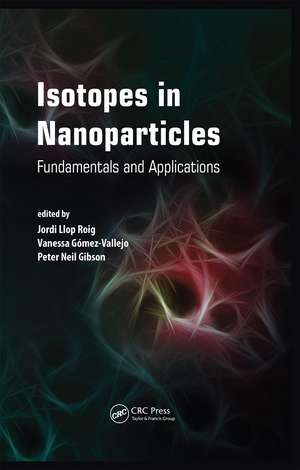Isotopes in Nanoparticles: Fundamentals and Applications
Editat de Jordi Llop, Vanessa Gomez-Vallejoen Limba Engleză Hardback – 22 mar 2016
Preț: 1022.69 lei
Preț vechi: 1371.23 lei
-25% Nou
Puncte Express: 1534
Preț estimativ în valută:
195.71€ • 212.52$ • 164.40£
195.71€ • 212.52$ • 164.40£
Comandă specială
Livrare economică 02-16 aprilie
Doresc să fiu notificat când acest titlu va fi disponibil:
Se trimite...
Preluare comenzi: 021 569.72.76
Specificații
ISBN-13: 9789814669085
ISBN-10: 9814669083
Pagini: 544
Ilustrații: 128
Dimensiuni: 152 x 229 mm
Greutate: 0.9 kg
Ediția:1
Editura: Jenny Stanford Publishing
Colecția Jenny Stanford Publishing
ISBN-10: 9814669083
Pagini: 544
Ilustrații: 128
Dimensiuni: 152 x 229 mm
Greutate: 0.9 kg
Ediția:1
Editura: Jenny Stanford Publishing
Colecția Jenny Stanford Publishing
Public țintă
Academic and PostgraduateCuprins
Introduction. Inorganic Nanoparticles. Oxide and Bioceramic Nanoparticles. Graphene, Carbon Nanotubes, and BCN Nanostructures. Polymeric Nanoparticles: Description, Synthesis, and Applications. A Brief Overview of Radioactivity. In vivo Evaluation of Nanoparticle Pharmacokinetics by Molecular Imaging: Technical Aspects. Radiolabelling of NPs Using Radiometals: 99mTc, 68Ga, 67Ga, 89Zr, and 64Cu. Radiolabelling of Nanoparticles Using Radiohalogens, 13N, and 11C. Radiolabelling of liposomes. Direct Ion-Beam Activation of Nanoparticles. Neutron Activation of Nanoparticles. 7-Beryllium-Recoil Labelling of Nanoparticles. Calculation Tools for Isotope Production by Beam Activation. Synthesis and Applications of Alpha/Beta Emitter-Labelled Nanoparticles. Radiochemical Stability Studies of Radiolabelled Nanoparticles. Labelling Nanoparticles with Non-radioactive Isotopes. Health and Safety Considerations for Radiolabelled Nanoparticles.
Recenzii
"This book is very comprehensive and timely, particularly because nanomaterials are being more widely used in numerous applications across society. It endeavors to be a comprehensive resource for scientists at all levels in the fields of nanomaterials and radiochemistry—and those who wish to learn about them. It is artfully constructed and leads us through available labeling strategies and the associated complexities of the multiple methods available for the preparation of radiolabeled nanomaterials. I fully recommend this book."
—Dr. Jason S. Lewis, Memorial Sloan Kettering Cancer Center, USA
"This book is an excellent companion for everybody who works with radioisotopes and nanomaterials, or who wants to start in this emerging field. The book gives a comprehensive overview from the basics of nanomaterial preparation, over radiolabeling procedures, to biomedical applications and imaging. Each reader, from senior researcher to graduate students, will enjoy this book as reference work or as study book, respectively."
—Prof. Dr. Tobias L. Ross, Hannover Medical School, Germany
—Dr. Jason S. Lewis, Memorial Sloan Kettering Cancer Center, USA
"This book is an excellent companion for everybody who works with radioisotopes and nanomaterials, or who wants to start in this emerging field. The book gives a comprehensive overview from the basics of nanomaterial preparation, over radiolabeling procedures, to biomedical applications and imaging. Each reader, from senior researcher to graduate students, will enjoy this book as reference work or as study book, respectively."
—Prof. Dr. Tobias L. Ross, Hannover Medical School, Germany
Notă biografică
Jordi Llop Roig received his PhD from the Department of Analytical Chemistry at Institut Químic de Sarrià (Ramon Llull University, Spain) in 2002. After postdoc stays at Clínica Universidad de Navarra (2002) and Uppsala University PET Centre (2002–2003), he worked at IAT-PRBB (Barcelona, Spain) from 2003 to 2007. In 2007, he moved to CIC biomaGUNE (San Sebastián, Spain), where he is principal investigator of the Radiochemistry and Nuclear Imaging group and head of Radiochemistry.
Vanessa Gómez-Vallejo received her PhD from the Department of Organic Chemistry at Institut Químic de Sarrià (Ramon Llull University) in 2010. Between 2005 and 2007, she worked as quality control manager of the Radiopharmaceutical Laboratory at IAT-PRBB. In 2007, she moved to CIC biomaGUNE (San Sebastián, Spain), where she manages the Radiochemistry Platform.
Peter Neil Gibson received his PhD in physics from Trinity College Dublin, with a thesis on the subject of radiation damage in vitreous silica. He is currently a senior scientist at the European Commission's Joint Research Centre at Ispra, Italy, in the Nanobiosciences Unit of the Institute for Health and Consumer Protection. His expertise is in materials science, with extensive experience in X-ray diffraction analysis, nanoparticle characterization, and cyclotron-based nanoparticle radiolabeling.
Vanessa Gómez-Vallejo received her PhD from the Department of Organic Chemistry at Institut Químic de Sarrià (Ramon Llull University) in 2010. Between 2005 and 2007, she worked as quality control manager of the Radiopharmaceutical Laboratory at IAT-PRBB. In 2007, she moved to CIC biomaGUNE (San Sebastián, Spain), where she manages the Radiochemistry Platform.
Peter Neil Gibson received his PhD in physics from Trinity College Dublin, with a thesis on the subject of radiation damage in vitreous silica. He is currently a senior scientist at the European Commission's Joint Research Centre at Ispra, Italy, in the Nanobiosciences Unit of the Institute for Health and Consumer Protection. His expertise is in materials science, with extensive experience in X-ray diffraction analysis, nanoparticle characterization, and cyclotron-based nanoparticle radiolabeling.
Descriere
This book starts with an introduction to the different types of nanomaterials most commonly used in both the biomedical and industrial areas. It then compiles and discusses the various methods reported to date for the radiolabelling of nanomaterials with imaging purposes, and provides illustrative examples of potential applications of the labelled species. Finally, the use of nanomaterials in radiotherapy, stable isotopic labeling strategies, and operational health and safety aspects related with the manipulation of NPs in radioactive facilities are discussed. This book will appeal to anyone involved in nanotechnology, molecular imaging, radiochemistry, and nanomedicine.
